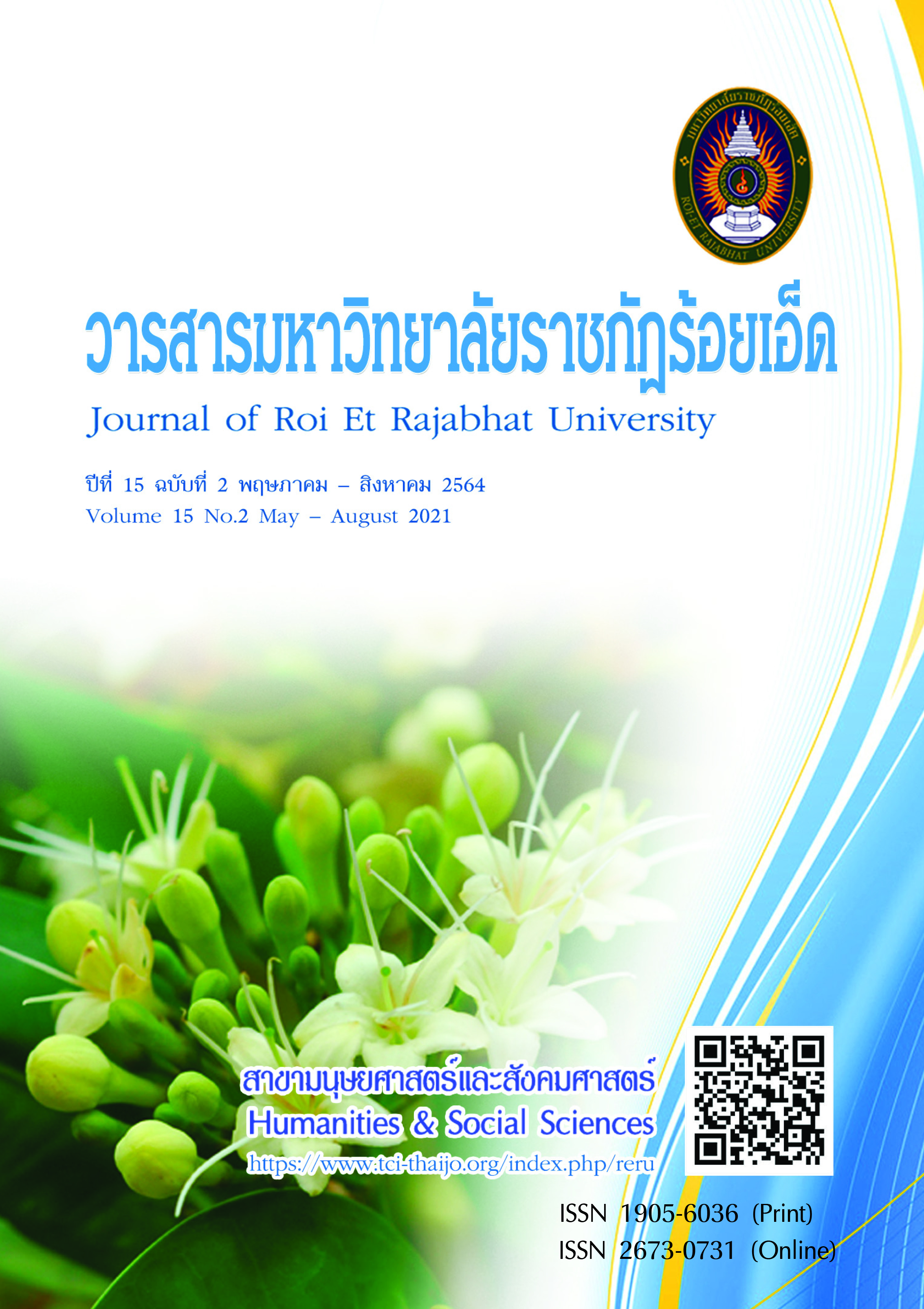Travel Routes in The Trace of Northeastern Folk Literature: Hundred Stories in Yasothon
Keywords:
Travel Routes, Northeastern Folk Literature, Stories in YasothonAbstract
The objectives of this research were to 1) studying the history, myths, culture and beliefs, 2) evaluate the potential and importance of tourist attractions related to Isan folk literature and 3) design travel routes in the trace of Northeastern Folk Literature: a hundred stories in Yasothon. The 2 sample groups were the qualitative samples that consisted of 18 representatives from government agencies, private sectors, and communities In the case study area by random sampling method, and the quantitative samples who were 400 Thai tourists from 8 travel routes in the trace of Northeastern Folk Literature by selecting 50 people in each place of the area, and using semi-structured interview and questionnaire. The data were analyzed by using content analysis and statistical techniques such as mean, percentage and standard deviation. The results showed that significance of cultural heritage and potential of tourist attractions at a high level in all aspects and map out the one-day travel routes in the traces of northeastern folk literature in Yasothon as follows: start at Phra That Anon, Ban Tha Sing Old Town Community, Yasothon City Pillar Shrine, Sri Thammamaram Temple, Phaya Khankhak Museum, Ban Song Yae Wooden Christian Church, Ban Si Than Khit Pillow Village, and finish at Phra That Kong Khao Noi that the government sectors and whom it concerns can apply this research results to map out the travel route in the trace of Northeastern Folklore and promote the cultural tourism in Yasothon Province due to increase of new generation tourists.
References
กฤษดา ขุ่นอาภัย. (2552). การท่องเที่ยวเชิงวัฒนธรรม: กรณีศึกษาบ้านลวงเหนือ ตำบลลวงเหนือ อำเภอเภอดอยสะเก็ด จังหวัดเชียงใหม่. การค้นคว้าแบบอิสระ ศิลปศาสตรมหาบัณฑิต สาขาวิชาการบริหารการพัฒนาสังคม. เชียงใหม่: มหาวิทยาลัยเชียงใหม่.
กาญจนา จันทร์สิงห์. (2560). งานประเพณีบุญบั้งไฟ. สืบค้นเมื่อ 20 สิงหาคม 2560, จาก https://arit.kpru.ac.th/ap2/local/?nu=pages&page_id=135&code_db=610004&code_type=01
ชลิตา เฉลิมรักชาติ. (2560). ความพึงพอใจของนักท่องเที่ยวชาวไทยที่มีต่อวัดร่องขุ่น จังหวัดเชียงราย. การค้นคว้าแบบอิสระ ศิลปศาสตรมหาบัณฑิต สาขาวิชาการจัดการอุตสาหกรรมการบริการและการท่องเที่ยว. ปทุมธานี: มหาวิทยาลัยกรุงเทพ.
บุญชม ศรีสะอาด. (2545). การวิจัยเบื้องต้น (พิมพ์ครั้งที่ 7). กรุงเทพฯ: สุวีริยาสาส์น.
เบญญทิพย์ ทองวิไล. (2559). การวิเคราะห์องค์ประกอบเชิงสำรวจของเส้นทางการท่องเที่ยวอำเภอปราณบุรี จังหวัดประจวบคีรีขันธ์ สำหรับนักท่องเที่ยวชาวไทย. การค้นคว้าอิสระ ศิลปศาสตรมหาบัณฑิต สาขาวิชาการจัดการอุตสาหกรรมการบริการและการท่องเที่ยว. ปทุมธานี: มหาวิทยาลัยกรุงเทพ.
ภัทรา แจ้งใจเจริญ. (2558). การจัดการการท่องเที่ยวเชิงวัฒนธรรมกรณีศึกษา ชุมชนโอหงิมาจิ หมู่บ้านชิราคาว่าโก จังหวัดกิฝุ ประเทศญี่ปุ่น. การค้นคว้าแบบอิสระ ศิลปศาสตรมหาบัณฑิต สาขาวิชาญี่ปุ่นศึกษา. กรุงเทพฯ: มหาวิทยาลัย
ธรรมศาสตร์.
วิภาวี พลรัตน์. (2551). การพัฒนารูปแบบการท่องเที่ยวเชิงนิเวศทางน้ำ: กรณีศึกษา ย้อนรอยเส้นทางประวัติศาสตร์อดีตราช ธานี
กรุงธนบุรี. การค้นคว้าแบบอิสระ วิทยาศาสตรมหาบัณฑิต สาขาวิชาการวางแผนและการจัดการการท่องเที่ยว เพื่ออนุรักษ์สิ่งแวดล้อม. กรุงเทพฯ: มหาวิทยาลัยศรีนครินทรวิโรฒ.
วีรพล ทองมา. (2554). การบริหารจัดการการท่องเที่ยวเชิงวัฒนธรรมอย่างยั่งยืนตามแนวปรัชญาเศรษฐกิจพอเพียงในพื้นที่
ลุ่มน้ำแม่งอน อำเภอฝาง จังหวัดเชียงใหม่. ทุนอุดหนุนการวิจัยจากสำนักงานคณะกรรมการวิจัยแห่งชาติ.
เชียงใหม่: มหาวิทยาลัยแม่โจ้.
สำนักงานการท่องเที่ยวและกีฬาจังหวัดยโสธร. (2560). จำนวนนักท่องเที่ยว/ รายได้จากการท่องเที่ยว. สืบค้นเมื่อ
เมษายน 2560, จาก https://yasothon.mots.go.th/more_news.php?cid=49
สุธาสินี วิยาภรณ์. (2559). การพัฒนาแหล่งท่องเที่ยวทางประวัติศาสตร์ ปราสาทสด๊กก๊อกธม จังหวัดสระแก้ว. การประชุม วิชาการและเสนอผลงานวิจัยระดับชาติ ครั้งที่ 3 ก้าวสู่ทศวรรษที่ 2: บูรณาการงานวิจัย ใช้องค์ความรู้
สู่ความยั่งยืน, 3, 545-555.
อภิญญา สุพิชญ์. (2556). การมีส่วนร่วมของชุมชนในการจัดการการท่องเที่ยวเชิงวัฒนธรรม: กรณีศึกษา บ้านสิงห์ท่า
อำเภอเมือง จังหวัดยโสธร. การค้นคว้าแบบอิสระ บริหารธุรกิจมหาบัณฑิต สาขาวิชาการจัดการการท่องเที่ยว.
ขอนแก่น: มหาวิทยาลัยขอนแก่น.
อัศวิน แสงพิกุล. (2556). ระเบียบวิธีวิจัยด้านการท่องเที่ยวและการโรงแรม. กรุงเทพฯ: มหาวิทยาลัยธุรกิจบัณฑิตย์.
Australia ICOMOS. (1999). The Burra Charter: The Australia ICOMOS Charter for Places of Cultural Signifincance 1999, Burwood: Australia ICOMOS. Retrieved January 22, 2018,
From https://www.patinations.com.au/pdf/the-burra-charter.pdf
Buhalis, D. (2000). Marketing the competitive destination in the future. Tourism Management, 21(1), 97-116.
Erose Sthapit. (2013). Tourists' Perceptions of Memorable Experiences: Testing the Memorable Tourism Experience Scale among Tourist to Rovaiemi Lapland. Independent Study Master of Arts Culture Tourism and International Management. Lapland: The University of Lapland.
ICOMOS China. (2015). Principles for the Conservation of Heritage Sites in China. China : The Getty Conservation Institute. Retrieved January 22, 2018, From http://www.getty.edu/conservation/publications_resources/pdf_publications/pdf/china_prin_heri tage_sites_2015.pdf
Krejcie, R.V. and Morgan, D.W. (1970). Determining Sample Size for Research Activities. Educational and Psychological Measurement, 30(3), 607-610.
Tourism Western Australia. (2009). Five’s of Tourism. Retrieved January 22, 2018,
From www.Tourism.wa.gov.au
Downloads
Published
How to Cite
Issue
Section
License
บทความที่ได้รับการตีพิมพ์เป็นลิขสิทธิ์ของวารสารมหาวิทยาลัยราชภัฎร้อยเอ็ด
ข้อความที่ปรากฏในบทความแต่ละเรื่องในวารสารวิชาการเล่มนี้เป็นความคิดเห็นส่วนตัวของผู้เขียนแต่ละท่านไม่เกี่ยวข้องกับมหาวิทยาลัยราชภัฎร้อยเอ็ด และคณาจารย์ท่านอื่นๆในมหาวิทยาลัยฯ แต่อย่างใด ความรับผิดชอบองค์ประกอบทั้งหมดของบทความแต่ละเรื่องเป็นของผู้เขียนแต่ละท่าน หากมีความผิดพลาดใดๆ ผู้เขียนแต่ละท่านจะรับผิดชอบบทความของตนเองแต่ผู้เดียว





